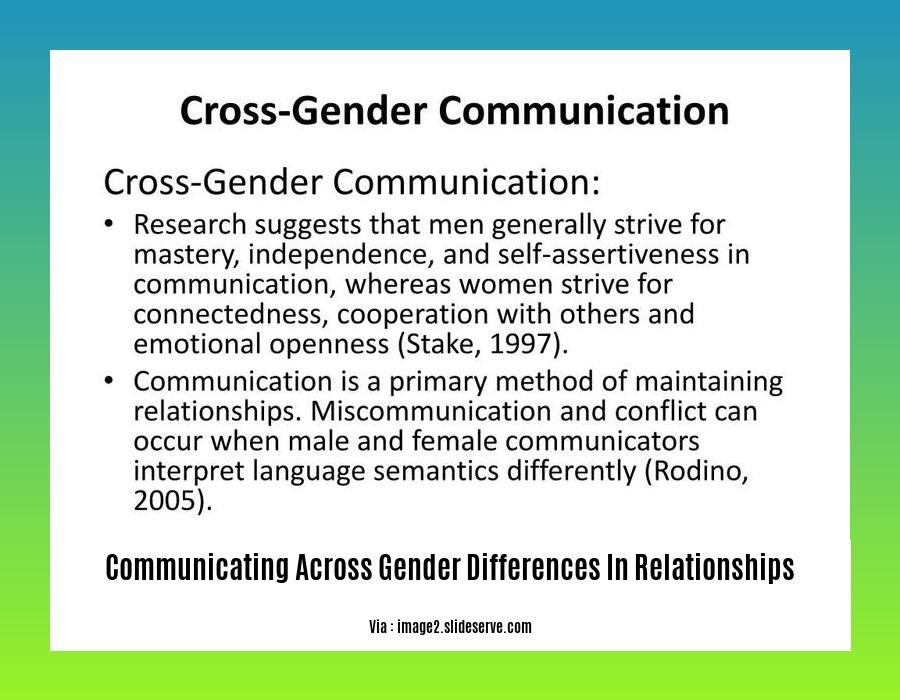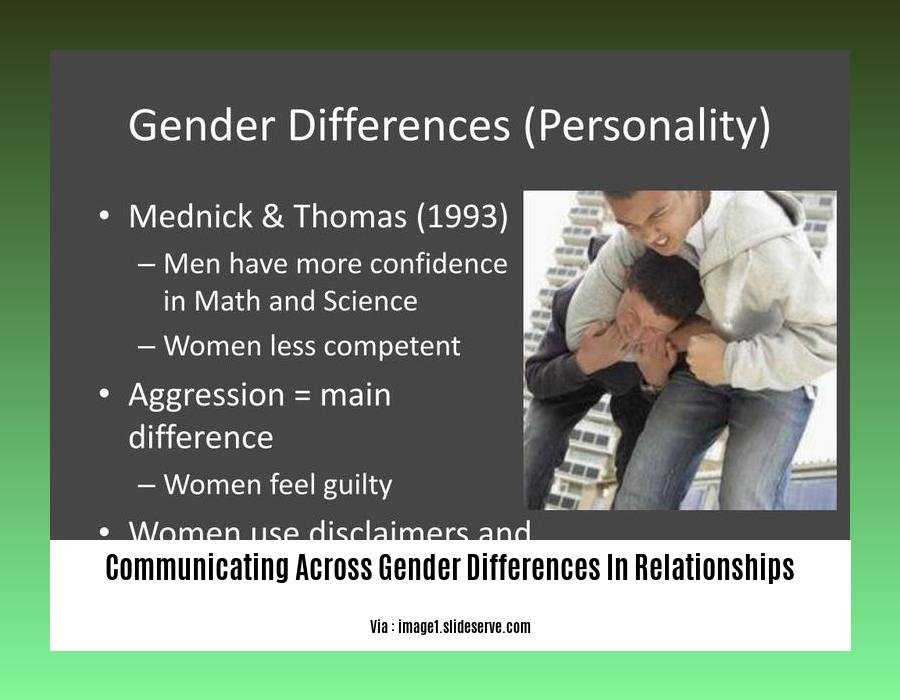Welcome to “The Art of Communicating Across Gender Differences in Relationships: A Guide to Bridging the Gap.” In this comprehensive guide, we’ll explore the unique challenges and opportunities that arise when individuals from different genders navigate relationships. We’ll delve into the gender biases, nonverbal cues, and communication styles that can shape interactions, and provide practical strategies for fostering cross-gender understanding and building more fulfilling connections. Whether you’re a man seeking to understand the complexities of female communication or a woman seeking to navigate the often-puzzling world of male communication, this guide will empower you with the knowledge and tools you need to bridge the gap and create truly connected relationships.
Key Takeaways:

- Understand that gender differences in socialization lead to misunderstandings in communication.
- Recognize that genders have distinct communication codes, norms, and practices.
- Knowing these differences can prevent conflicts and misinterpretations.
- Women often use more abstract language, while men tend to be more direct.
- Men may be more prone to interrupting and taking control of conversations.
- Women often express emotions and seek support more openly.
Communicating Across Gender Differences in Relationships
In the tapestry of human relationships, the threads of gender communication can weave either vibrant connections or tangled knots. Understanding these differences is crucial for navigating cross-gender interactions with ease and empathy.
Socialization and Communication Codes
Gender socialization shapes our communication codes, norms, and practices. Women tend to prioritize connection and emotional expressiveness, while men often focus on status and assertiveness. These differences can lead to misunderstandings if not acknowledged and addressed.
Example: A woman may express a concern indirectly by saying, “I feel a bit uncomfortable,” while a man might state it more directly: “I’m not okay with this.”
Conversational Styles
Men and women also differ in their conversational styles. Men tend to be more directive and interrupt more often, while women are more supportive and collaborative. These differences can create imbalances if not managed effectively.
Tip: If you notice one gender dominating conversations, consciously adjust by actively listening and inviting the other to share their perspectives.
Emotional Expression
Emotions play a significant role in communication. Women tend to express emotions more openly and seek support, while men may be more guarded and focus on problem-solving. This can sometimes lead to frustration or resentment.
Strategy: Encourage open and honest emotional expression by creating a safe and non-judgmental space. Listen attentively and validate feelings, even if you don’t fully agree.
Bridging the Gap
Understanding gender communication differences is the first step towards bridging the gap. Here are some tips to enhance cross-gender understanding:
- Be aware of your own communication style. Reflect on how your gender socialization influences your communication.
- Be respectful of different perspectives. Remember that others may have different ways of expressing themselves.
- Use clear and direct language. Avoid using vague or abstract terms that may be easily misunderstood.
- Listen actively and ask clarifying questions. Show that you’re engaged in the conversation and want to truly understand what’s being said.
- Focus on the message, not the messenger. Separate the content of a message from the gender of the person delivering it.
Remember: Communicating across gender differences requires empathy, understanding, and a willingness to bridge the gap. By embracing these principles, you can create more fulfilling and harmonious relationships.
To truly understand the intricacies of cross-gender communication, it’s essential to explore the understanding differing communication needs and tendencies, gaining insights into the unique ways in which men and women approach communication. To bridge the gender communication gap, delve into ways to bridge the gender communication gap and discover practical strategies for more effective cross-gender dialogue, empowering yourself with the tools to navigate the complexities of gendered communication.
Men Are Fixers
As we navigate relationships, understanding gendered communication differences becomes crucial. One common observation is the tendency for men to adopt the role of “fixers.”
Why Men Are Fixers
- Socialization: From a young age, boys are often encouraged to be independent and problem-solvers.
- Learned Behaviors: Men may have observed and emulated this behavior from their fathers or other male role models.
- Avoidance of Vulnerability: By focusing on solutions, men may subconsciously avoid expressing emotions or acknowledging their own needs.
Impact on Communication
While the intention to “fix” can be well-meaning, it can sometimes lead to misunderstandings:
- Women may feel dismissed: When men quickly offer solutions, women may feel their emotions are not being fully understood or validated.
- Lack of empathy: The focus on solutions can overshadow the need for empathy and emotional support.
- Power dynamics: In some cases, men’s fixer role can create a dynamic where they are perceived as more authoritative or controlling.
Addressing the Issue
To bridge this communication gap, consider these strategies:
- Validate Emotions: Allow women to express their emotions without immediately jumping to solutions.
- Active Listening: Listen attentively to both the words and emotions being communicated.
- Seek Understanding: Ask clarifying questions to ensure you fully comprehend the other person’s perspective.
- Collaborate: Involve women in the solution-finding process, fostering a sense of partnership.
Key Takeaways:
- Men are socialized to be fixers.
- This role can sometimes lead to misunderstandings in relationships.
- Validating emotions and practicing active listening can help bridge the gap.
Women Want to Be Heard
When it comes to communication between men and women, there’s often a disconnect. It’s not that we’re speaking different languages, but rather that we have different ways of expressing ourselves. As a result, women want to be heard, and men may not always be the best at listening.
Why Women Want to Be Heard
There are a few reasons why women want to be heard. First, they want to feel understood. When they share their thoughts and feelings, they want to know that the other person is actually listening and trying to understand their perspective. Second, women want to feel valued. When they are heard, they feel like their thoughts and feelings matter. Third, women want to feel connected. When they can communicate openly and honestly with someone, they feel closer to that person.
How to Listen to Women
So, how can men better listen to women? Here are a few tips:
- Pay attention to what she’s saying. Don’t just wait for your turn to talk. Really listen to what she’s saying and try to understand her perspective.
- Ask questions. If you don’t understand something, ask her to clarify. This will show her that you’re interested in what she’s saying and that you want to make sure you understand her.
- Validate her feelings. Even if you don’t agree with her, let her know that you understand how she’s feeling. This will help her feel heard and valued.
- Don’t try to fix her problems. Sometimes, women just want to vent. They don’t need you to fix their problems. Just listen to them and let them know that you’re there for them.
Key Takeaways:
- Women want to be heard because they want to feel understood, valued, and connected.
- Men can better listen to women by paying attention, asking questions, validating their feelings, and not trying to fix their problems.
Most Relevant URL Source:
The Seven Most Asked Questions About Gender Communication











